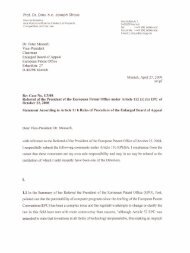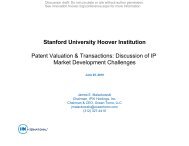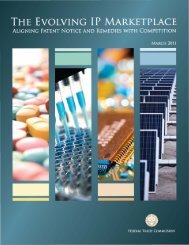Assessing the Obstacles to Industrialisation: The ... - Innovation
Assessing the Obstacles to Industrialisation: The ... - Innovation
Assessing the Obstacles to Industrialisation: The ... - Innovation
Create successful ePaper yourself
Turn your PDF publications into a flip-book with our unique Google optimized e-Paper software.
28 Stephen H. Habersimilar decline, with <strong>the</strong> value of capital in equipment and buildings per active mill falling by 13 % between 1922 and ~ ~ r ~ . ~ ~ <strong>The</strong> lack of capital spending was driven by <strong>the</strong> pessimism of inves<strong>to</strong>rs,who were revaluing <strong>the</strong>ir assets downwards. An analysis of <strong>the</strong> ratio ofmarket-<strong>to</strong>-book values for <strong>the</strong> three firms discussed above indicates thatinves<strong>to</strong>rs perceived that <strong>the</strong>ir assets were worth only yo % of what <strong>the</strong>yhad perceived <strong>the</strong>m <strong>to</strong> be prior <strong>to</strong> <strong>the</strong> Revolution. Along with a declinein <strong>the</strong> value of assets came concomitant jumps in s<strong>to</strong>ck yields, as inves<strong>to</strong>rsbegan <strong>to</strong> demand a sizeable risk premium in order <strong>to</strong> stay in <strong>the</strong> Mexicanmarket. <strong>The</strong> average yield on common s<strong>to</strong>ck in Mexico's major industrialcompanies increased from 4.6% per annum during <strong>the</strong> period betweenI 896 and I 910 <strong>to</strong> 9.4% per annum between 1918 and 1925. Similarly, realfinancial returns <strong>to</strong> inves<strong>to</strong>rs increased sixfold; jumping from 3 % perannum during <strong>the</strong> period I 90 1-1 o <strong>to</strong> I 8.7% during <strong>the</strong> period from 19I 8<strong>to</strong> 1925, <strong>the</strong> result of a dramatic fall in <strong>the</strong> real market values of s<strong>to</strong>cksbetween 1910 and 1918, which produced sizeable capital gains for thosewilling <strong>to</strong> invest in <strong>the</strong> market afterward^.^' <strong>The</strong>re is also evidence that <strong>the</strong>-1920s were a period of capital flight in hIexico, as inves<strong>to</strong>rs began <strong>to</strong> keepmore of <strong>the</strong>ir cash assets abroad."<strong>The</strong> pessimism of <strong>the</strong> investment community in Mexico was borne outin <strong>the</strong> latter part of <strong>the</strong> 1920s as hIexico began <strong>to</strong> enter <strong>the</strong> GreatDepression. Beginning in 1926 <strong>the</strong> prices of Mexican exports went on adownhill roller coaster ride. Between 1926 and 1928 export revenues fellby ten per cent, from $3 34 million <strong>to</strong> $299 million. <strong>The</strong> drop accelerated<strong>the</strong>reafter, with exports eventually falling <strong>to</strong> only $97 million in I 93L Thisdrop was not compensated for by a similar drop in import prices. Not onlydid <strong>the</strong> volume of exports decline by 37 % between 1929 and 1932, but <strong>the</strong>terms of trade deteriorated by 21 % as well. Thus, <strong>the</strong> purchasing powerof Mexican exports fell by over 50 % in just three years. <strong>The</strong> negativeeffects of <strong>the</strong> collapse of <strong>the</strong> export sec<strong>to</strong>r, which had significant effects onemployment and demand, were exacerbated by pro-cyclical monetary andfiscal policies.'1 Though <strong>the</strong> estimates are rough, <strong>the</strong> available dataindicate that real per capita Gross Domestic Product fell by 5 .g% in 13.27,0.9% in 1928, 5.4% in 1929, and 7.7% in 1930. In 1931 <strong>the</strong>re was a slightrecovery, with an increase in GDP of I.j %, but it was not long-lasting.For a detailed discussed of <strong>the</strong> effects of <strong>the</strong> Revolution, as well as a discussion of hou<strong>the</strong>sevalues were calculated, see Haber, Ind/is.fr, and Ynderdt-celopment, ch. 8.'' For a detailed discussion of <strong>the</strong> sources and methods employed in this analysis seeHaber, Industry and Cnderdetelopment, pp. 144-8'' Joseph Sterrett and Joseph Davis, Tile Fircal and Economic Condition oj .Ilexico (Nea-~.York, 1928), p. 190. " F.nrique Cardenas, La industriali?acion n/exicana d~rante la Gran Depresion (Mexico, 1987), chs. 3 and 4.





